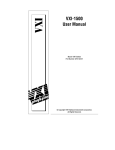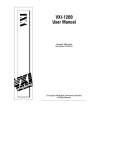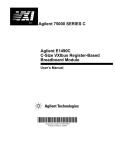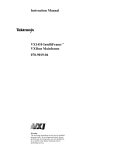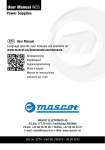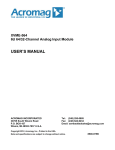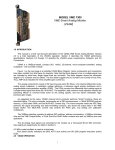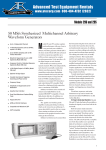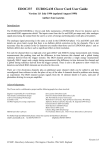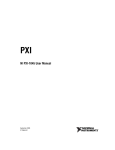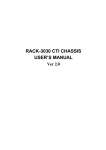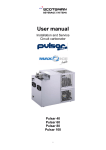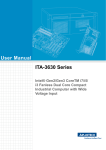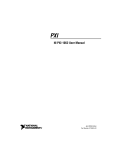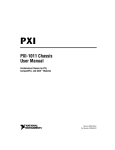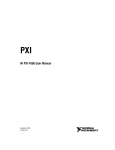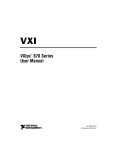Download VXI-1000 Mainframe User Manual
Transcript
VXI-1000 Mainframe User Manual bus November 1993 Edition Part Number 320207-01 © Copyright 1989, 1994 National Instruments Corporation. All Rights Reserved. National Instruments Corporate Headquarters 6504 Bridge Point Parkway Austin, TX 78730-5039 (512) 794-0100 Technical support fax: (800) 328-2203 (512) 794-5678 Branch Offices: Australia (03) 879 9422, Austria (0662) 435986, Belgium 02/757.00.20, Canada (Ontario) (519) 622-9310, Canada (Québec) (514) 694-8521, Denmark 45 76 26 00, Finland (90) 527 2321, France (1) 48 14 24 24, Germany 089/741 31 30, Italy 02/48301892, Japan (03) 3788-1921, Netherlands 03480-33466, Norway 32-848400, Spain (91) 640 0085, Sweden 08-730 49 70, Switzerland 056/20 51 51, U.K. 0635 523545 Limited Warranty The VXI-1000 is warranted against defects in materials and workmanship for a period of one year from the date of shipment, as evidenced by receipts or other documentation. National Instruments will, at its option, repair or replace equipment that proves to be defective during the warranty period. This warranty includes parts and labor. A Return Material Authorization (RMA) number must be obtained from the factory and clearly marked on the outside of the package before any equipment will be accepted for warranty work. National Instruments will pay the shipping costs of returning to the owner parts which are covered by warranty. National Instruments believes that the information in this manual is accurate. The document has been carefully reviewed for technical accuracy. In the event that technical or typographical errors exist, National Instruments reserves the right to make changes to subsequent editions of this document without prior notice to holders of this edition. The reader should consult National Instruments if errors are suspected. In no event shall National Instruments be liable for any damages arising out of or related to this document or the information contained in it. EXCEPT AS SPECIFIED HEREIN, NATIONAL INSTRUMENTS MAKES NO WARRANTIES, EXPRESS OR IMPLIED, AND SPECIFICALLY DISCLAIMS ANY WARRANTY OF MERCHANTABILITY OR FITNESS FOR A PARTICULAR PURPOSE. CUSTOMER'S RIGHT TO RECOVER DAMAGES CAUSED BY FAULT OR NEGLIGENCE ON THE PART OF NATIONAL INSTRUMENTS SHALL BE LIMITED TO THE AMOUNT THERETOFORE PAID BY THE CUSTOMER. NATIONAL INSTRUMENTS WILL NOT BE LIABLE FOR DAMAGES RESULTING FROM LOSS OF DATA, PROFITS, USE OF PRODUCTS, OR INCIDENTAL OR CONSEQUENTIAL DAMAGES , EVEN IF ADVISED OF THE POSSIBILITY THEREOF. This limitation of the liability of National Instruments will apply regardless of the form of action, whether in contract or tort, including negligence. Any action against National Instruments must be brought within one year after the cause of action accrues. National Instruments shall not be liable for any delay in performance due to causes beyond its reasonable control. The warranty provided herein does not cover damages, defects, malfunctions, or service failures caused by owner's failure to follow the National Instruments installation, operation, or maintenance instructions; owner's modification of the product; owner's abuse, misuse, or negligent acts; and power failure or surges, fire, flood, accident, actions of third parties, or other events outside reasonable control. Copyright Under the copyright laws, this publication may not be reproduced or transmitted in any form, electronic or mechanical, including photocopying, recording, storing in an information retrieval system, or translating, in whole or in part, without the prior written consent of National Instruments Corporation. Trademarks Product and company names listed are trademarks or trade names of their respective companies. Warning Regarding Medical and Clinical Use of National Instruments Products National Instruments products are not designed with components and testing intended to ensure a level of reliability suitable for use in treatment and diagnosis of humans. Applications of National Instruments products involving medical or clinical treatment can create a potential for accidental injury caused by product failure, or by errors on the part of the user or application designer. Any use or application of National Instruments products for or involving medical or clinical treatment must be performed by properly trained and qualified medical personnel, and all traditional medical safeguards, equipment, and procedures that are appropriate in the particular situation to prevent serious injury or death should always continue to be used when National Instruments products are being used. National Instruments products are NOT intended to be a substitute for any form of established process, procedure, or equipment used to monitor or safeguard human health and safety in medical or clinical treatment. FCC/DOC Radio Frequency Interference Compliance This equipment generates and uses radio frequency energy and, if not installed and used in strict accordance with the instructions in this manual, may cause interference to radio and television reception. This equipment has been tested and found to comply with the following two regulatory agencies: Federal Communications Commission This device complies with Part 15 of the Federal Communications Commission (FCC) Rules for a Class A digital device. Operation is subject to the following two conditions: 1. This device may not cause harmful interference in commercial environments. 2. This device must accept any interference received, including interference that may cause undesired operation. Canadian Department of Communications This device complies with the limits for radio noise emissions from digital apparatus set out in the Radio Interference Regulations of the Canadian Department of Communications (DOC). Le présent appareil numérique n’émet pas de bruits radioélectriques dépassant les limites applicables aux appareils numériques de classe A prescrites dans le règlement sur le brouillage radioélectrique édicté par le ministère des communications du Canada. Instructions to Users These regulations are designed to provide reasonable protection against harmful interference from the equipment to radio reception in commercial areas. Operation of this equipment in a residential area is likely to cause harmful interference, in which case the user will be required to correct the interference at his own expense. There is no guarantee that interference will not occur in a particular installation. However, the chances of interference are much less if the equipment is installed and used according to this instruction manual. If the equipment does cause interference to radio or television reception, which can be determined by turning the equipment on and off, one or more of the following suggestions may reduce or eliminate the problem. • Operate the equipment and the receiver on different branches of your AC electrical system. • Move the equipment away from the receiver with which it is interfering. • Reorient or relocate the receiver’s antenna. • Be sure that the equipment is plugged into a grounded outlet and that the grounding has not been defeated with a cheater plug. Notice to user: Changes or modifications not expressly approved by National Instruments could void the user’s authority to operate the equipment under the FCC Rules. If necessary, consult National Instruments or an experienced radio/television technician for additional suggestions. The following booklet prepared by the FCC may also be helpful: How to Identify and Resolve Radio-TV Interference Problems. This booklet is available from the U.S. Government Printing Office, Washington, DC 20402, Stock Number 004-000-00345-4. Contents About This Manual ..............................................................................................................ix Organization of This Manual ...........................................................................................ix Conventions Used in This Manual...................................................................................ix Related Documents ..........................................................................................................x Customer Communication ...............................................................................................x Operator's Safety Summary .............................................................................................xi Chapter 1 Introduction ..........................................................................................................................1-1 Features ..........................................................................................................................1-1 Unpacking ......................................................................................................................1-2 What Your Kit Should Contain......................................................................................1-2 Optional Equipment .......................................................................................................1-3 Chapter 2 Preparation for Use and Operation..............................................................................2-1 Safety .............................................................................................................................2-1 Orientation .....................................................................................................................2-1 Front Panel .....................................................................................................................2-1 Rear Panel ......................................................................................................................2-1 Current Protection and Grounding.................................................................................2-2 Module/Backplane Current Protection...............................................................2-2 Checking Line Voltage ......................................................................................2-3 Cooling Fans ..................................................................................................................2-3 Bus Grant and Interrupt Acknowledge Daisy-Chains....................................................2-3 Chapter 3 Structural Design ................................................................................................................3-1 Top and Bottom Cover Design ......................................................................................3-2 Painting ..........................................................................................................................3-2 Carrying Handle and Rack-Mounting Slide Capability.................................................3-2 VXI Module Filler Panels..............................................................................................3-2 Chapter 4 Backplane...............................................................................................................................4-1 Power Monitor ...............................................................................................................4-1 Battery Back-Up ............................................................................................................4-1 VXIbus Module Connectors ..........................................................................................4-1 Chapter 5 Power Supply........................................................................................................................5-1 Features ..........................................................................................................................5-1 Power Supply Ratings....................................................................................................5-2 Power Supply Fusing .....................................................................................................5-3 © National Instruments Corporation v VXI-1000 Mainframe User Manual Contents Chapter 6 Cooling System.....................................................................................................................6-1 VXI Module Cooling .....................................................................................................6-1 Two-Speed Fan Control.....................................................................................6-2 Power Supply Cooling ...................................................................................................6-2 Variable-Load Fan Speed Control .....................................................................6-2 General Fan and Noise Characteristics ..........................................................................6-2 Appendix A Specifications ........................................................................................................................A-1 Input Power....................................................................................................................A-1 Backplane.......................................................................................................................A-1 Power Supply .................................................................................................................A-2 Module Cooling .............................................................................................................A-3 Environmental................................................................................................................A-4 Physical ..........................................................................................................................A-4 Appendix B Customer Communication............................................................................................... B-1 Glossary ......................................................................................................................Glossary-1 VXI-1000 Mainframe User Manual vi © National Instruments Corporation Contents Figures Figure 1-1. VXI-1000 Mainframe ....................................................................................... 1-1 Figure 2-1. Figure 2-2. VXI-1000 Rear Panel Layout ........................................................................... 2-2 Bus Grant and Interrupt Acknowledge Jumper Locations for P1..................... 2-4 Figure 3-1. VXI-1000 Mainframe Structural Design.......................................................... 3-1 Figure 4-1. 96-Pin VXIbus Connector ................................................................................ 4-1 Figure 5-1. Three Levels of Electrical Fuse Protection....................................................... 5-3 Figure 6-1. VXI-1000 Cooling System ............................................................................... 6-1 Figure A-1. VXI Module Cooling Performance Curve........................................................ A-3 Tables Table 1-1. Power Cord Information................................................................................... 1-3 Table 4-1. Table 4-2. Table 4-3. VXIbus P1 Module Connector Pin Assignments ............................................. 4-2 VXIbus Module P2 Connector Pin Assignments (Slot 0) ................................ 4-3 VXIbus Module P2 Connector Pin Assignments (Slots 1-4) ........................... 4-4 Table 5-1. Power Supply Ratings....................................................................................... 5-2 Table 6-1. Fan and Noise Characteristics .......................................................................... 6-2 Table Table Table Table Input Power Specifications............................................................................... A-1 Power Supply Specifications ............................................................................ A-2 Environmental Specifications........................................................................... A-4 Physical Specifications ..................................................................................... A-4 A-1. A-2. A-3. A-4. © National Instruments Corporation vii VXI-1000 Mainframe User Manual About This Manual The VXI-1000 Mainframe User Manual describes the features, functions, and operation of the VXI-1000 mainframe. Organization of This Manual The VXI-1000 Mainframe User Manual is organized as follows: • Chapter 1, Introduction, describes the features of the VXI-1000, lists the contents that should be included with your kit, and lists optional equipment. • Chapter 2, Structural Design, describes the construction of the VXI-1000. • Chapter 3, Preparation for Use and Operation, contains safety information and details on how to configure the VXI-1000 before use and then operate it safely. • Chapter 4, Backplane, contains a description of the backplane circuit board. • Chapter 5, Power Supply, describes the compact switching power supply in the VXI-1000. • Chapter 6, Cooling System, describes the cooling and airflow system used in the VXI-1000. • Appendix A, Specifications, contains the system, electrical, environmental, and mechanical specifications for the VXI-1000. • Appendix B, Customer Communication, contains forms you can use to request help from National Instruments or to comment on our products and manuals. • The Glossary contains an alphabetical list of terms used in this manual and a description of each. Conventions Used in This Manual Throughout this manual, the following conventions are used to distinguish elements of text: italic Italic text denotes emphasis, a cross reference, or an introduction to a key concept. bold italic Bold italic text denotes a note, caution, or warning. * An asterisk (*) following a signal mnemonic indicates the signal is active when in the low state (typically, 0.0 to 0.8 volts). A signal mnemonic without a trailing asterisk denotes the signal is active when in the high state (typically, 2.8 to 5.0 V). Numbers in this manual are decimal (base 10) unless otherwise noted. © National Instruments Corporation ix VXI-1000 Mainframe User Manual About This Manual Related Documents The following documents contain information that you may find helpful as you read this manual: • IEEE Standard for a Versatile Backplane Bus: VMEbus, ANSI/IEEE Std 1014-1987 • VXIbus System Specification, Revision 1.4, VXIbus Consortium (available from National Instruments, part number 350083-01) • VXIbus Mainframe Extender Specification, VXI-6, Rev. 1.0, VXIbus Consortium (available from National Instruments, part number 340258-01) Customer Communication National Instruments wants to receive your comments on our products and manuals. We are interested in the applications you develop with our products, and we want to help if you have problems with them. To make it easy for you to contact us, this manual contains comment and configuration forms for you to complete. These forms are in Appendix B, Customer Communication, at the end of this manual. VXI-1000 Mainframe User Manual x © National Instruments Corporation Operator's Safety Summary The general safety information in this summary is for both operating and servicing personnel. Specific warnings and cautions are found throughout the manual where they apply, and may not appear in this summary. Terms in This Manual Power Source WARNING statements identify conditions or practices that could result in personal injury or loss of life or damage to the mainframe or other property. The VXI-1000 is intended to operate from a power source that does not apply more than 250 VAC between the line power conductors or between either conductor and earth ground. Terms as Marked on Mainframe Grounding DANGER indicates a personal injury hazard immediately accessible as one reads the marking. The VXI-1000's chassis is connected to earth ground through the ground conductor of the line power cord. To avoid electrical shock, plug the mainframe power cord into a properly wired receptacle. A protective ground connection is essential for safe operation. CAUTION indicates a personal injury hazard not immediately accessible as one reads the markings, or a hazard to the property, including the mainframe itself. Symbols as Marked on Mainframe Danger Arising from Loss of Ground ATTENTION--refer to manual. If the protective ground connection is lost, all accessible conductive parts can render an electric shock. Refer to manual before using. DANGER--High Voltage. Protective ground (earth) terminal. Use the Proper Fuse To avoid fire hazard, use replacement fuses of the type, voltage rating, and current rating specified. Covers and Panels To avoid personal injury, the VXI-1000's covers should be removed only by qualified service personnel. Do not operate the mainframe without covers and panels properly installed. © National Instruments Corporation Do Not Operate in Explosive Atmosphere To avoid explosion, do not operate the mainframe in an explosive atmosphere. xi VXI-1000 Mainframe User Manual Chapter 1 Introduction This chapter describes the features of the VXI-1000 VXIbus mainframe (hereafter called the VXI-1000), lists the contents that should be included with your kit, and lists optional equipment. The VXI-1000 is a completely integrated 5-slot, C-size VXI support system. It incorporates the highest industry standards in backplane EMI/signal performance, pressurized cooling capability, high-efficiency power distribution, module development access, and support maintenance. Features The VXI-1000 is a 5-slot VXIbus mainframe that is fully compatible with the VXIbus System Specification, and is compliant with UL, FCC, and VEDA standards. It is designed to be used in benchtop (horizontal), tower (vertical), or rack-mounted applications. The VXI-1000 has two 96-pin VXIbus connectors (P1 and P2) per module slot for full access to the VXIbus resources associated with C-size modules. Figure 1-1 shows the VXI-1000 mainframe in the benchtop configuration. Art not available in PDF version of document. Figure 1-1. VXI-1000 Mainframe © National Instruments Corporation 1-1 VXI-1000 Mainframe User Manual Introduction Chapter 1 In its full configuration, the VXI-1000 has the following features: • • • • • • • • VXIbus compatible, 5-slot C-size fully integrated mainframe Two-speed pressurized-directed airflow, 40 to 50 W per slot cooling system High-quality, 50 ohm/time-matched signal lines, multi-layer backplane Jumperless Bus Grant and IACK daisy-chain connectors Compact 400 W switching power supply with autoranging Rugged, EMI-protected structural design Removable top and bottom covers for VXI module development access Optional 3.5 in. floppy drive or hard drive Unpacking Inspect the shipping container and its contents for damage. If damage appears to have been caused in shipment, file a claim with the carrier. Retain the packing material for possible inspection and/or reshipment. What Your Kit Should Contain Your kit should contain the following components: Component Part Number VXI-1000 Mainframe with four blank filler panels 191000-01 VXI-1000 User Manual 320207-01 Power Cord See Table 1-1. Make sure each of these items is in your kit. If any item is missing, contact National Instruments. The overall kit number for your VXI-1000 kit is determined by the power cord you specified, as shown in Table 1-1. VXI-1000 Mainframe User Manual 1-2 © National Instruments Corporation Chapter 1 Introduction Table 1-1. Power Cord Information VXI-1000 Kit No. Power Cord Reference Standards 776323-01 Standard 120 V ANSI C73.11/NENA 5-15-P/IEC83 776323-02 Switzerland 220 V SEV 776323-03 Australia 240 V AS C112 776323-04 Universal Euro 240 V CEE (7), II, IV, VII IEC 83 776323-05 North America 240 V ANSI C73.20/NENA 5-15-P/IEC83 776323-06 UK 240 V BS 1363/IEC83 Optional Equipment Component Part Number Rack-Mount Kit 776324-01 3.5 in. Floppy Disk Drive or Hard Drive Data Storage © National Instruments Corporation 1-3 Contact National Instruments VXI-1000 Mainframe User Manual Chapter 2 Preparation for Use and Operation This chapter contains safety information and details on how to configure the VXI-1000 before use and then operate it safely. Safety Before connecting the mainframe to a power source, read this chapter and the Operator's Safety Summary located in the front of this manual. Orientation The VXI-1000 can be operated in either the benchtop (horizontal) or vertical (tower) orientation. The VXI-1000 has feet for stability in either orientation. Front Panel The only feature on the front panel is the POWER on/off switch. This switch controls application of the AC voltages to the power supply. It operates only when line power is applied to the rear panel connector. Additional operating features apply if your VXI-1000 contains the optional 3.5 in. floppy disk or hard drive. Consult the documentation that came with the floppy disk drive or hard drive unit for further details. Rear Panel The rear panel of the VXI-1000 has the following features. • • • • Power cord connector Main power fuse Fan speed switch (HI/LOW) VXI module and power supply cooling fans with their respective air filter The filters have snap off/on type covers for easy removal of the washable filter pads. Check and clean both filters routinely to guard against dirt or lint buildup that could inhibit the cooling abilities of the unit. Use mild detergent in warm water to wash the filter pads. © National Instruments Corporation 2-1 VXI-1000 Mainframe User Manual Preparation for Use and Operation Chapter 2 Figure 2-1 shows the location of the features on the rear panel. Art not available in PDF version of document. Figure 2-1. VXI-1000 Rear Panel Layout Current Protection and Grounding This section contains information about current protection, line voltage requirements, line fuses, and power cord grounding. Module/Backplane Current Protection The main power supply fuse, located on the rear panel of the VXI-1000, provides overload and short protection for the unit. This 250 V, Slow Blow 12 A for 110 VAC (6.3 A for 220 VAC) fuse is designed to fail before other power assets are adversely affected. The AC input to the power supply and each power output is protected by individual in-line fuses. The fuse holders are part of the power supply mounted to the rear panel. Warning: All installed modules that use mainframe power supply voltages should be current-protected on the module to protect both the module and the mainframe. Mainframe damage caused by shorted modules that are not current-protected may void all or part of the mainframe warranty. VXI-1000 Mainframe User Manual 2-2 © National Instruments Corporation Chapter 2 Preparation for Use and Operation This manual provides the documentation required by the VXIbus specification Rule B.8.7 that allows you to verify compatibility between mainframe output power capability and module supply requirements. It is your responsibility to ensure the peak current capacity of the mainframe (IMP–see Table 5-1) exceeds the sum of the peak module currents (IPM) of all installed modules for each supply used. It is also your responsibility to ensure the dynamic current capability of the mainframe (IMD–see Table 5-1) exceeds the sum of the dynamic current (IDM) requirements of the installed modules for each supply used. For more information, refer to Section B.8.5, Power Management, of the VXIbus specification. Checking Line Voltage The mainframe operates with autoranging that automatically adjusts for a 115 V (nominal) or 230 V (nominal) single-phase power source with a line frequency between 47 to 63 Hz. Make certain that the voltage is within one of the following ranges before connecting the power cord to the power source on the rear panel. Refer to Table 1-1 to verify that your power cord is appropriate for your VXI-1000. • 115 V nominal – 90 to 130 VAC • 230 V nominal – 180 to 264 VAC Warning: The mainframe can be damaged if it is operated with a power source line voltage that is outside the proper range. Cooling Fans The VXI-1000 contains two fans. One cools the VXI modules and the other cools the power supply. Use the fan switch located on the rear panel to select between full speed and low-speed fan operation for cooling the installed modules. You can use low speed for low power conditions and for user development when quiet operation is more important than heat dissipation. Select full speed when all slots are occupied or under heavy load conditions. The power supply cooling fan speed is automatically regulated by the power consumption from the 5 V power supply. Bus Grant and Interrupt Acknowledge Daisy-Chains Jumpers are used on conventional backplanes to propagate the bus grant and interrupt acknowledge signals across unused slots. These signals are normally propagated by each installed module from the appropriate input pin (BGxIN* or IACKIN*) to the appropriate output pin (BGxOUT* or IACKOUT*). © National Instruments Corporation 2-3 VXI-1000 Mainframe User Manual Preparation for Use and Operation Chapter 2 The VXI-1000 is equipped with jumperless P1 connectors. These connectors provide a standard closed condition for propagating daisy-chain signals across unused slots. Slot 0 Slot 1 Slot 2 BG0 BG1 BG2 BG3 IACK Slot 3 BG0 BG1 BG2 BG3 Slot 4 BG0 BG1 BG2 BG3 Slot 1 Jumpers Slot 2 Jumpers Slot 3 Jumpers IACK IACK IACK Figure 2-2. Bus Grant and Interrupt Acknowledge Jumper Locations on P1 The VXI-1000 also has a manual override for the jumperless connectors. You can use the additional manual back-up jumper connections on the P1 connector as shown in Figure 2-2 in the event the jumperless connector fails. When using the manual override feature, make certain that the Bus Grant jumpers located adjacent to Slots 1 through 4, and the Interrupt Acknowledge jumpers located adjacent to Slots 0 through 4, are configured properly. Before installing each module, check the jumpers associated with the slot(s) where the module is to be installed, and install them as the module requires. VXI-1000 Mainframe User Manual 2-4 © National Instruments Corporation Chapter 3 Structural Design This chapter describes the construction of the VXI-1000. The rugged, EMI-protected structural design ensures that the unit can withstand the high electromagnetic environments found in most laboratory applications. Figure 3-1 shows the VXI-1000 with the top cover removed. Art not available in PDF version of document. Figure 3-1. VXI-1000 Mainframe Structural Design © National Instruments Corporation 3-1 VXI-1000 Mainframe User Manual Structural Design Chapter 3 Top and Bottom Cover Design By removing the top and bottom covers, you can access installed modules from either side while being protected from internal electrical or mechanical hazards. When you remove the 16 Phillips screws that hold each cover in place, the cover easily slips off its bezel and horizontal frame strut. Inner sheet metal covers protect you from potential hazards within the chassis. Warning: Do not remove the inner covers; to do so will cause misalignment of the card guides and may expose you to hazardous electrical high power situations. Painting A two-coat textured paint process protects external surfaces most susceptible to abrasion. Carrying Handle and Rack-Mounting Slide Capability A collapsible handle is mounted on the side of the unit for easy portability. Four rubber feet support the unit in either benchtop (horizontal) or tower (vertical) configurations. The VXI-1000 has built-in attachment points for rack-mounting slides should you wish to purchase and install optional slide mounts for use in a rack-mount system. VXI Module Filler Panels The VXI-1000 is shipped from the factory with four blank filler panels to cover empty slots, thereby maintaining adequate air flow in the mainframe and reducing electromagnetic emissions. VXI-1000 Mainframe User Manual 3-2 © National Instruments Corporation Chapter 4 Backplane This chapter contains a description of the backplane circuit board. The VXI-1000 uses a multi-layer, standard C-size backplane that can accommodate up to five VXIbus modules. The backplane serves as the VMEbus and VXIbus interface for each of the five module slots and provides termination for the bus signals. The backplane fully complies with the VXIbus specification and gives complete grounding, signal separation, signal integrity up to 100 MHz, and EMI protection. It also has precision time-matching (<200 picoseconds) and impedance matching (<5%) to ensure a minimum skew for clock lines. Power Monitor The power monitor coordinates the activities of the power switch, power supplies, and ACFAIL* signals generated by installed modules. This circuitry ensures that the VXI-1000 generates the proper timing between the ACFAIL*, SYSRESET*, and +5 V signals at power-up and powerdown. Warning: To guard against failure of the VXI-1000 power failure monitor, do not cycle AC power within 5 seconds. Battery Back-Up An external +5 V standby power source can be connected to the +5STDBY and GND terminals. The terminals are located on the rear side of the backplane. If you would like this option, contact National Instruments. Do not open the unit to install this option yourself. VXIbus Module Connectors The VXIbus module connectors consist of two 96-pin DIN connectors (P1 and P2) for each of the five module slots. Figure 4-1 shows the VXIbus connector. The pin and signal information for these connectors can be found in Tables 4-1, 4-2, and 4-3. Art not available in PDF version of document. Figure 4-1. 96-Pin VXIbus Connector © National Instruments Corporation 4-1 VXI-1000 Mainframe User Manual Backplane Chapter 4 Table 4-1 describes the P1 connections. Table 4-1. VXIbus P1 Module Connector Pin Assignments Pin Row A Signals Row B Signals Row C Signals 1 2 3 4 5 6 7 8 9 10 11 12 13 14 15 16 17 18 19 20 21 22 23 24 25 26 27 28 29 30 31 32 D00 D01 D02 D03 D04 D05 D06 D07 GND SYSCLK GND DS1* DS0* WRITE* GND DTACK* GND AS* GND IACK* IACKIN* IACKOUT* AM4 A07 A06 A05 A04 A03 A02 A01 -12 V +5 V BBSY* BCLR* ACFAIL* BG0IN* BG0OUT* BG1IN* BG1OUT* BG2IN* BG2OUT* BG3IN* BG3OUT* BR0* BR1* BR2* BR3* AM0 AM1 AM2 AM3 GND SERCLK SERDAT* GND IRQ7* IRQ6* IRQ5* IRQ4* IRQ3* IRQ2* IRQ1* +5VSTDBY +5 V D08 D09 D10 D11 D12 D13 D14 D15 GND SYSFAIL* BERR* SYSRESET* LWORD* AM5 A23 A22 A21 A20 A19 A18 A17 A16 A15 A14 A13 A12 A11 A10 A09 A08 +12 V +5 V VXI-1000 Mainframe User Manual 4-2 © National Instruments Corporation Chapter 4 Backplane Table 4-2 describes the P2 connections for Slot 0 modules. Table 4-2. VXIbus Module P2 Connector Pin Assignments (Slot 0) Pin Row A Signals 1 2 3 4 5 6 7 8 9 10 11 12 13 14 15 16 17 18 19 20 21 22 23 24 25 26 27 28 29 30 31 32 ECLTRG0 -2 V ECLTRG1 GND MODID12 MODID11 -5.2 V MODID10 MODID09 GND MODID08 MODID07 -5.2 V MODID06 MODID05 GND MODID04 MODID03 -5.2 V MODID02 MODID01 GND TTLTRG0* TTLTRG2* +5 V TTLTRG4* TTLTRG6* GND RSV2 MODID00 GND SUMBUS © National Instruments Corporation Row B Signals +5 V GND RSV1 A24 A25 A26 A27 A28 A29 A30 A31 GND +5 V D16 D17 D18 D19 D20 D21 D22 D23 GND D24 D25 D26 D27 D28 D29 D30 D31 GND +5 V 4-3 Row C Signals CLK10+ CLK10GND -5.2 V LBUSC00 LBUSC01 GND LBUSC02 LBUSC03 GND LBUSC04 LBUSC05 -2 V LBUSC06 LBUSC07 GND LBUSC08 LBUSC09 -5.2 V LBUSC10 LBUSC11 GND TTLTRG1* TTLTRG3* GND TTLTRG5* TTLTRG7* GND RSV3 GND +24 V -24 V VXI-1000 Mainframe User Manual Backplane Chapter 4 Table 4-3 describes the P2 connections for modules in other slots. Table 4-3. VXIbus Module P2 Connector Pin Assignments (Slots 1-4) Pin Row A Signals 1 2 3 4 5 6 7 8 9 10 11 12 13 14 15 16 17 18 19 20 21 22 23 24 25 26 27 28 29 30 31 32 ECLTRG0 -2 V ECLTRG1 GND LBUSA00 LBUSA01 -5.2 V LBUSA02 LBUSA03 GND LBUSA04 LBUSA05 -5.2 V LBUSA06 LBUSA07 GND LBUSA08 LBUSA09 -5.2 V LBUSA10 LBUSA11 GND TTLTRG0* TTLTRG2* +5 V TTLTRG4* TTLTRG6* GND RSV2 MODID GND SUMBUS VXI-1000 Mainframe User Manual Row B Signals +5 V GND RSV1 A24 A25 A26 A27 A28 A29 A30 A31 GND +5 V D16 D17 D18 D19 D20 D21 D22 D23 GND D24 D25 D26 D27 D28 D29 D30 D31 GND +5 V 4-4 Row C Signals CLK10+ CLK10GND -5.2 V LBUSC00 LBUSC01 GND LBUSC02 LBUSC03 GND LBUSC04 LBUSC05 -2 V LBUSC06 LBUSC07 GND LBUSC08 LBUSC09 -5.2 V LBUSC10 LBUSC11 GND TTLTRG1* TTLTRG3* GND TTLTRG5* TTLTRG7* GND RSV3 GND +24V -24V © National Instruments Corporation Chapter 5 Power Supply This chapter describes the compact switching power supply in the VXI-1000. It supports seven DC outputs in accordance with the VXIbus specification. Caution: All outputs have over-voltage protection. An over-voltage condition on any of the power supply output modules will cause the power supply to shut down. Before resetting the supply, remove AC power for a minimum of two minutes. Refer to Appendix A, Specifications, for more power supply specifications. Features The VXI-1000 power supply has the following features. • • • • • • Independent voltage overload and short circuit protection Minimal voltage regulation change due to line voltage and load variations Thermal protection Autoranging (110 VAC or 230 VAC) Ripple/noise filtered Variable-speed cooling fan © National Instruments Corporation 5-1 VXI-1000 Mainframe User Manual Power Supply Chapter 5 Power Supply Ratings Table 5-1 shows the ratings of the power supply outputs. These ratings are within the acceptable limits of the VXIbus specification and support the general requirements of test module development. Ripple is also within the acceptable limits of the VXIbus specification. Table 5-1. Power Supply Ratings DC Output Voltage Accuracy DC Current1 AC Current2 Power PARD3 +5 V +5/-2.5 % 35.0 A 1.3 A 175 W <50 mV +12 V +5/-3.0 % 4.5 A 4.0 A 30 W <50 mV -12 V +5/-3.0 % 2.0 A 1.3 A 24 W <50 mV +24 V +5/-3.0 % 2.0 A 2.0 A 48 W <150 mV -24 V +5/-3.0 % 2.0 A 2.0 A 48 W <150 mV -2 V ±5/-5.0 % 4.0 A 0.3 A 8W <50 mV -5.2 V +5/-3.0 % 10.0 A 0.5 A 52 W <50 mV 0.0 A 0.0 A 0W +5 V STDBY Notes: N/A N/A 1. Peak DC current defined as IMP in the VXIbus specification. 2. Dynamic AC current defined as IMD in the VXIbus specification. 3. PARD = Periodic and Random Deviations (volts peak-to-peak, 2 Hz to 10 MHz). VXI-1000 Mainframe User Manual 5-2 © National Instruments Corporation Chapter 5 Power Supply Power Supply Fusing The VXI-1000 has three levels of fusing to protect against high current/voltage conditions, as shown in Figure 5-1. Fusing begins with a 12 A Slow-Blow fuse at the power entry module for 110 VAC (6.3 A for 230 VAC) located at the rear panel of the unit. The second level of protection is built into the power supply at the AC entry point where a 15 A Slow-Blow fuse is installed. The third level of protection is facilitated at each of the DC outputs except for the 2 V and 5 V outputs. Power Entry Module Fuse (12 A or 6.3 A) Power Supply AC Input Fuse (15 A) Individual DC Output Fuses Figure 5-1. Three Levels of Electrical Fuse Protection The most sensitive protection is at the power entry module. You can easily access this fuse on the rear panel and replace it without opening the mainframe. The other fuses should be replaced by National Instruments. Warning: The mainframe can be damaged if it is improperly fused. Replace fuses with the same type and rating as specified. © National Instruments Corporation 5-3 VXI-1000 Mainframe User Manual Chapter 6 Cooling System This chapter describes the cooling and airflow system used in the VXI-1000. The cooling system maintains cooling of power supplies and VXI modules at >40 W per slot (10° C rise). Two high-volume, low-noise fans cool different parts of the unit. A two-speed fan cools the VXI modules, and a variable-speed fan cools the power supply. Both fans draw air from the rear of the unit through easy access filters. VXI Module Cooling The VXI module fan channels air through a pressurized plenum duct system that distributes the airflow through exhaust ports directly into the underside of the modules, as shown in Figure 6-1. This design ensures constant airflow and removes the need for alternate routing under any module configuration or front panel baffle installation. The card guides serve as additional ducting by acting as baffles to ensure that the air is channeled into the module and not redirected around them. The vents at the top and sides of the chassis give a 1:2 ratio of intake:exhaust to ensure a minimum restriction of airflow. Side and Top Exhaust Ports From the Mainframe Power Supply Power Supply Variable Speed Fan Air Intake e lan p ack B Air Jet Action Input to VXI Module Filter Air Intake VXI Module Two Speed Fan Air Duct/Plenum Figure 6-1. VXI-1000 Cooling System The VXI-1000 is capable of dissipating heat at 40 to 50 W per module slot for a 10° C rise, as required by the VXIbus specification. © National Instruments Corporation 6-1 VXI-1000 Mainframe User Manual Cooling System Chapter 6 Two-Speed Fan Control The speed of the module cooling fan is controlled by the speed selector switch located on the rear panel. The low-speed setting is suitable for development environments where quiet operation is more important than maximum heat dissipation. Power Supply Cooling The power supply fan pulls air through the filter unit directly into the power supply. The physical layout of the power supply modules and the openings at each end ensure that the air is routed to the areas that generate the most heat. Variable-Load Fan Speed Control The power supply fan is controlled by a feedback loop that monitors the 5 V power output. As the load increases on the 5 V line, the speed of the fan increases automatically to ensure an increased. General Fan and Noise Characteristics The fans are mounted with damping studs on the rear panel of the mainframe to reduce noise. Each fan also features an electronic rotor safety lock that shuts down power to the rotor if the fan stops or jams, and resets and starts automatically when the fan is freed to rotate. The fan speed adjusts from a low/high condition of 0.2/0.8 in. water pressure at 100/182 CFM, with a noise level of 29/49 dB, within the respective enclosure. Table 6-1 shows fan and noise characteristics. Table 6-1. Fan and Noise Characteristics Maximum Airflow Maximum Air Pressure Noise (dB) Speed Speed (rpm) Current (A) CFM CMM In. of Water mm of Water Intake Exhaust High 3600 0.255 45.41 1.29 0.211 5.37 40.0 40.0 Low 1800 0.120 24.64 0.70 0.056 1.43 23.0 23.0 VXI-1000 Mainframe User Manual 6-2 © National Instrument Corporation Appendix A Specifications This appendix contains various performance specifications of the VXI-1000. Input Power The VXI-1000 operates on 115 VAC single-phase line power with a 250 V, 12 A Slow Blow fuse or on 220 VAC single-phase line power with a 250 V, 6.3 A Slow Blow fuse. The lighted power switch on the front panel controls AC power application to the VXI-1000. Table A-1 describes the input power specifications of the VXI-1000. Table A-1. Input Power Specifications Characteristic Power Input Requirements Autoranging Voltage Range: 115 V Nominal 230 V Nominal Frequency Inrush Surge Current Power Consumption Heat Dissipation Specification 90 to 130 VAC 180 to 264 VAC 47 to 63 Hz 68 A maximum for up to 40 ms at 115 VAC 30 A maximum for up to 40 ms at 230 VAC 575 W maximum 1535 Btu per hour (489 W) maximum Backplane The backplane is a 12-layer, VXIbus C-size circuit board that acts as the interface between the installed VXIbus modules. It has the following characteristics. • • • • • • • Standard 6U (13.986 in. high) C-size by 6.58 in. wide Can accommodate up to five C-size VXIbus modules at the standard 1.2 in. spacing Jumperless daisy-chain connectors Signal integrity up to 100 MHz EMI protection for backplane signals Fully complies with VXIbus specification Precision time-matching of <200 picoseconds and impedance-matching of <5% ensures a minimum skew for clock lines and minimum propagation delays between slots © National Instruments Corporation A-1 VXI-1000 Mainframe User Manual Specifications Appendix A Power Supply The VXI-1000 power supply meets the criteria in VXIbus System Specification, Section B.8. Safety certifications: • • • • UL 1244 CSA 22.2 No. 220 CSA bulletin 1402C EN 60 950 Table A-2 describes the specifications of the power supply. Table A-2. Power Supply Specifications Characteristic Specification Autoranging Selects operating voltages of 90 to 130 VAC or 180 to 264 VAC at 47 to 63 Hz Soft Start Prevents initial power surge on critical power supply and backplane components Soft Shutdown Holds power for a minimum of 20 ms after power loss Line Regulation ±0.1% or ±5 mV Load Regulation ±0.2% or ±10 mV for load changes from 50% to 0% or 100% of maximum rated values Ripple/Noise filtration To <150 mV for ±24 VDC and <50 mV for other supplies Shock Tested to MIL-STD 810-D Method 516.3, Procedure III Vibration Tested to MIL-STD 810-D Method 514.3, Category 1, Procedure I VXI-1000 Mainframe User Manual A-2 © National Instruments Corporation Appendix A Specifications Module Cooling A two-speed cooling fan ensures that the VXI-1000 is capable of dissipating heat at >40 W per slot for a 10° C rise, as required by the VXIbus specification. The high-volume, low-noise fan draws air from the rear of the unit into the pressurized plenum. The cooling capacity decreases as a function of the pressure drop across the installed module. Figure A-1 depicts the cooling performance curve for the worst slot at low fan speed. PRESSURE DROP in. of mm of water water 0.10 2.5 0.08 2.0 0.06 1.5 0.04 1.0 0.02 0.5 0.00 0 1 2 3 4 5 6 7 8 9 10 11 Liters/ second cu ft/min 5 10 15 20 25 AIRFLOW Figure A-1. VXI Module Cooling Performance Curve © National Instruments Corporation A-3 VXI-1000 Mainframe User Manual Specifications Appendix A Environmental Table A-3 describes the environmental specifications of the VXI-1000. Table A-3. Environmental Specifications Characteristic Temperature Operating Storage EMI Specification 0° to 50° C without derating Derating of 2.5% per ° C above 50° C, up to 70° C -55° C to +85° C FCC Class A Physical Table A-4 describes the physical specifications of the VXI-1000. Table A-4. Physical Specifications Characteristic Slots Number Size Specification Accommodates up to five single-wide VXI modules, including one Slot 0 module and four other modules C-size Dimensions Height Width Depth 7 in. (177.8 mm) 17 in. (431.8 mm) 22 in. (558.8 mm) Weight 29 lb. VXI-1000 Mainframe User Manual A-4 © National Instruments Corporation Appendix B Customer Communication For your convenience, this appendix contains forms to help you gather the information necessary to help us solve technical problems you might have as well as a form you can use to comment on the product documentation. Filling out a copy of the Technical Support Form before contacting National Instruments helps us help you better and faster. National Instruments provides comprehensive technical assistance around the world. In the U.S. and Canada, applications engineers are available Monday through Friday from 8:00 a.m. to 6:00 p.m. (central time). In other countries, contact the nearest branch office. You may fax questions to us at any time. Corporate Headquarters (512) 795-8248 Technical support fax: (800) 328-2203 (512) 794-5678 Branch Offices Australia Austria Belgium Denmark Finland France Germany Italy Japan Netherlands Norway Spain Sweden Switzerland U.K. Phone Number (03) 879 9422 (0662) 435986 02/757.00.20 45 76 26 00 (90) 527 2321 (1) 48 14 24 00 089/741 31 30 02/48301892 (03) 3788-1921 03480-33466 32-848400 (91) 640 0085 08-730 49 70 056/20 51 51 0635 523545 © National Instruments Corporation Fax Number (03) 879 9179 (0662) 437010-19 02/757.03.11 45 76 71 11 (90) 502 2930 (1) 48 14 24 14 089/714 60 35 02/48301915 (03) 3788-1923 03480-30673 32-848600 (91) 640 0533 08-730 43 70 056/20 51 55 0635 523154 B-1 VXI-1000 Mainframe User Manual Technical Support Form Photocopy this form and update it each time you make changes to your software or hardware, and use the completed copy of this form as a reference for your current configuration. Completing this form accurately before contacting National Instruments for technical support helps our applications engineers answer your questions more efficiently. If you are using any National Instruments hardware or software products related to this problem, include the configuration forms from their user manuals. Include additional pages if necessary. Name Company Address Fax ( ) Mainframe Phone ( ) VXI-1000 Slot 0 Controller brand Model Processor Operating system Speed Mouse MHz yes Hard disk capacity RAM no MB MB Display adapter Other adapters installed Brand Instruments used National Instruments hardware product model Revision Configuration National Instruments software product Configuration The problem is List any error messages The following steps will reproduce the problem Version VXI-1000 Hardware and Software Configuration Form Record the settings and revisions of your hardware and software on the line to the right of each item. Complete a new copy of this form each time you revise your software or hardware configuration, and use this form as a reference for your current configuration. Completing this form accurately before contacting National Instruments for technical support helps our applications engineers answer your questions more efficiently. National Instruments Products • • VXI-1000 kit number is dependent on the power cord in your kit. Refer to your packing slip. – Part Number 776323- – Serial Number Line Voltage: – Power Source (115 V or 230 V nominal) __________________________________________________ – Line Frequency (VAC) __________________________________________________ Slot 0 1 2 3 4 Module Description Logical Address Interrupt Level Module Function Documentation Comment Form National Instruments encourages you to comment on the documentation supplied with our products. This information helps us provide quality products to meet your needs. Title: VXI-1000 Mainframe User Manual Edition Date: November 1993 Part Number: 320207-01 Please comment on the completeness, clarity, and organization of the manual. If you find errors in the manual, please record the page numbers and describe the errors. Thank you for your help. Name Title Company Address Phone Mail to: ( ) Technical Publications National Instruments Corporation 6504 Bridge Point Parkway, MS 53-02 Austin, TX 78730-5039 Fax to: Technical Publications National Instruments Corporation MS 53-02 (512) 794-5678 Glossary Prefix Meaning Value mM- millimega- 10-3 106 ° degrees Ω ohms A amperes AC alternating current backplane The printed circuit board that is mounted in a mainframe to serve as the interface between modules. Btu British Thermal Unit C Celsius CFM cubic feet per minute CMM cubic meters per minute daisy-chain A method of propagating signals along a bus, in which the devices are prioritized on the basis of their position on the bus. dB decibel DC direct current EMI electromagnetic interference Hz hertz (cycles per second) IMD mainframe dynamic current IMP mainframe peak current in. inches lb. pounds MB megabytes of memory © National Instruments Corporation Glossary-1 VXI-1000 Mainframe User Manual Glossary m meter P1 The leftmost backplane connector for given slot in a horizontal mainframe such as the VXI-1000 (when viewed from the front panel side). P2 The rightmost backplane connector for a given slot in a horizontal mainframe such as the VXI-1000 (when viewed from the front panel side). PARD Periodic and Random Deviations power monitor A device that monitors line and backplane power and detects faults. A power monitor can generate the power-down and power-up timing required by the VXIbus specification. rpm revolutions per minute s seconds Slot 0 module A VXIbus device that provides the VMEbus System Controller services and the VXIbus CLK10 and MODID functions. Additional Slot 0 services include trigger control. V volts VAC volts alternating current VDC volts direct current W watts VXI-1000 Mainframe User Manual Glossary-2 © National Instruments Corporation






































